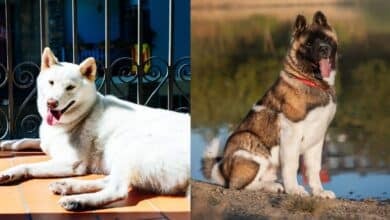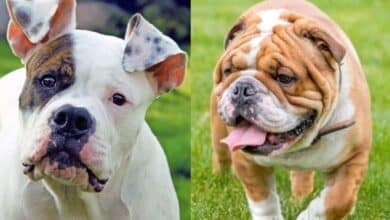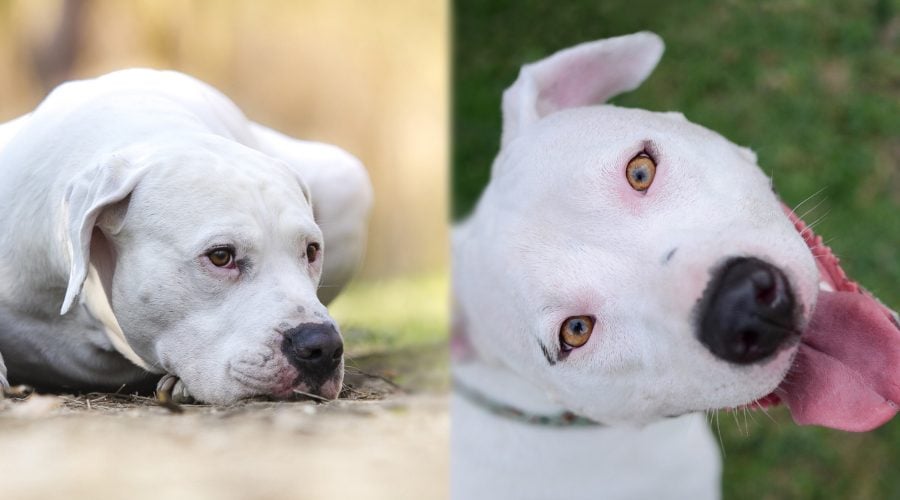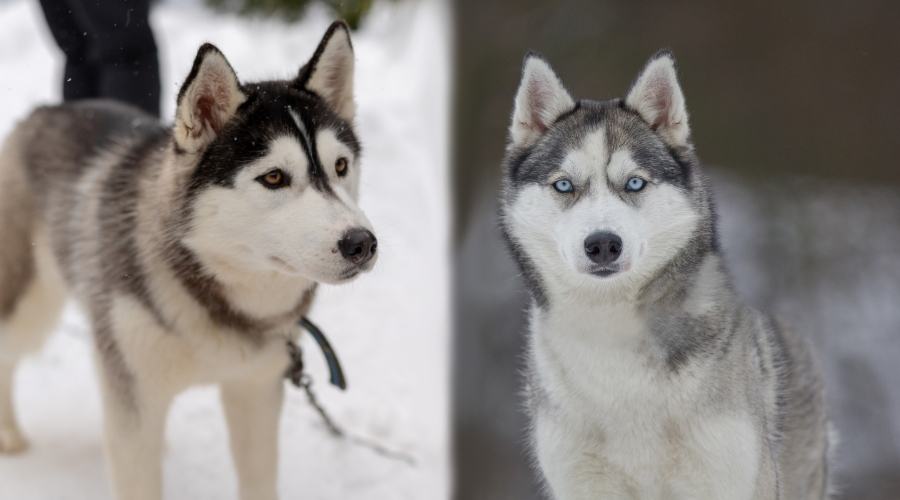Deer Head vs Apple Head Chihuahua: Differences & Similarities
When you purchase through links on our site, we may earn a commission. Here’s how it works.
So you have decided on a Chihuahua and thought your only remaining decision is whether to get a short-haired or long-haired Chihuahua, right? Wrong! Although the deer head Chihuahua and the apple head Chihuahua are the same breed of dog, they have a different appearance, and with that comes different health issues, which is something to consider.
Table of Contents
The apple head is a term used for Chihuahuas with a round forehead and bigger eyes. A deer head has a narrower skull, and his head has the same look as that of a young deer. The apple head is the only shape accepted in most world kennel clubs. However, he also has more health issues than the deer head.
These pups shouldn’t be confused with Chihuahua mixes, so we will look at the differences between the apple head and the deer head Chihuahua and dive straight into the details.
Breed Comparison
- Height5-8 inches
- Height5-8 inches
- Weight3-6 pounds
- Weight3-6 pounds
- Coat ColorBlack, Blue, Brown, Tan, White, Fawn, Red
- Coat ColorBlack, Blue, Brown, Tan, White, Fawn, Red
- TemperamentLoyal, friendly, intelligent, bold
- TemperamentLoyal, friendly, intelligent, bold
- EnergyHigh
- EnergyHigh
- HealthAverage
- HealthBelow average
- Lifespan14-16 years
- Lifespan14-16 yeaars
- Puppy Prices$300+
- Puppy Prices$1,500+
Chihuahua Breed History
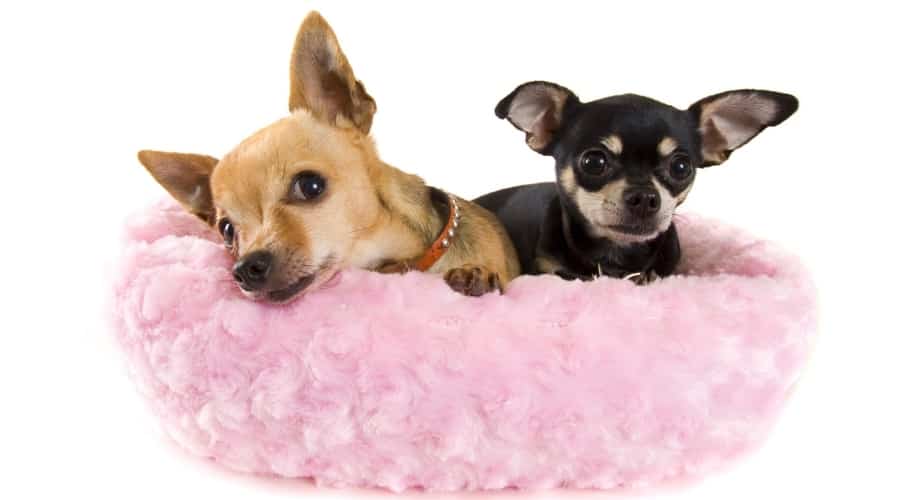
The Chihuahua originates as far back as the 9th Century, from what is now known as Mexico. It is believed their ancestor was a Techichi, which looked similar but much larger.
Their history in the early Toltec society is unknown, but when the Aztecs conquered the Toltecs, the Chihuahua became very popular. They were believed to heal the sick and predict the future. These pups were sacrificed and cremated alongside their owner, as it was believed that they would guide his owner’s spirit in the afterlife. When the Spanish conquered the Aztecs, they became less popular, and their numbers diminished significantly.
When Americans took interest in the breed, the majority of them were found in the Mexican State of Chihuahua, which is how they came to be known as Chihuahuas.
Travelers took them back to America, refined the breed, and entered them into shows. The first ‘official’ Chihuahua, named Midget, was registered with the American Kennel Club (AKC) in 1904, and he has been a big hit since.
Chihuahuas are very popular family pets. The AKC has them currently ranked as the 34th most popular dog in America as of 2022. He is described as charming, graceful, and sassy.
They have also played leading roles, such as Legally Blonde’s sidekick, Bruiser Woods, who was a deer head Chihuahua. They are also favorites amongst celebrities, such as Paris Hilton’s Tinkerbell, who was an apple head Chihuahua.
Appearance
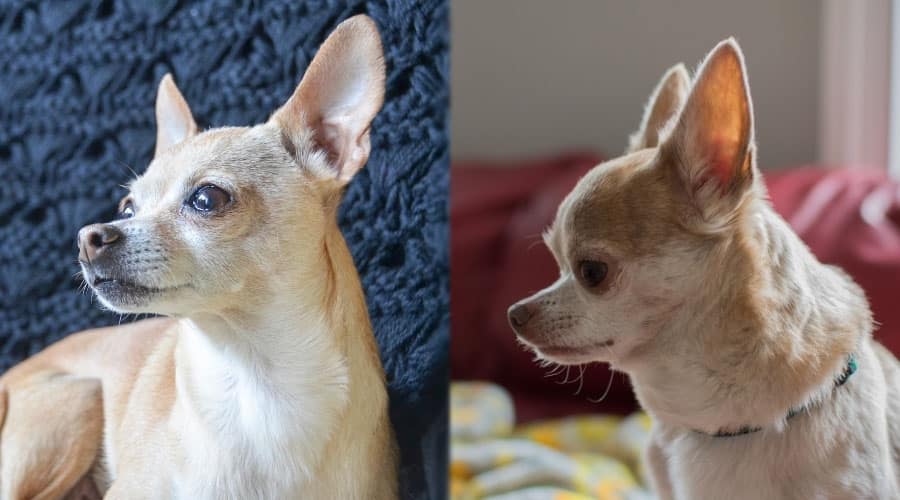
There are two types of Chihuahua: long-haired and short-haired. The apple head and the deer head can be either type. The breed is a small-size dog who, according to breed standards, should not exceed six pounds in weight and are generally 5 to 8 inches tall.
The Chihuahua is the smallest dog breed of them all. Sometimes, it is not clear which shaped head the pup has by just looking at him. The best way to tell is to look at his parents. He will mature fully at the age of one and is usually fully grown by six months.
Apple Head Chihuahua
The apple-shaped head is the most popular Chihuahua because he is currently the only head shape that is recognized by the AKC breed standards, described as a well-rounded “apple dome” skull.” He has a shorter muzzle, with a 90-degree angle between the muzzle and the skull, or an ‘L’ shape as it is also described.
He also has more prominent bulging eyes compared to the deer head Chihuahua. The apple head is also more likely to have a molera compared to the deer head, which is a soft spot on the skull. The apple head has smaller ears than his deer head brother.
Only apple head Chihuahuas can be presented in conformation shows due to their head shape. Even purebred, papered deer head Chihuahuas cannot be in conformation shows. However, the deer head is not prevented from partaking in any performance-related events such as agility or obedience.
Deer Head Chihuahua
The deer-shaped head is the least popular of the two shapes, but not by a significant amount. Generally, deer heads are larger than apple heads with an extended jawline. They have a narrower skull. The angle between their muzzle and the skull is less of an angle than the apple, normally at around 45 degrees.
Deer head Chihuahuas have a longer neck and a larger head compared to the apple head. He also has longer legs and looks more slender than short and squat like the apple head. Although the deer head is the larger of the two, toy deer heads do exist. He has slightly larger ears that are pointier, again, similar to that of a baby deer.
Because of their mysterious Toltec history, it is unknown why there are two different head shapes or when this difference occurred. Ancient Toltec art depicts both the deer and the apple-shaped heads.
Because of his head shape, it is theorized that the deer head Chihuahua is a cross between the Techichi and the Chinese Crested, who is also part of the toy group and has a similar temperament.
Temperament
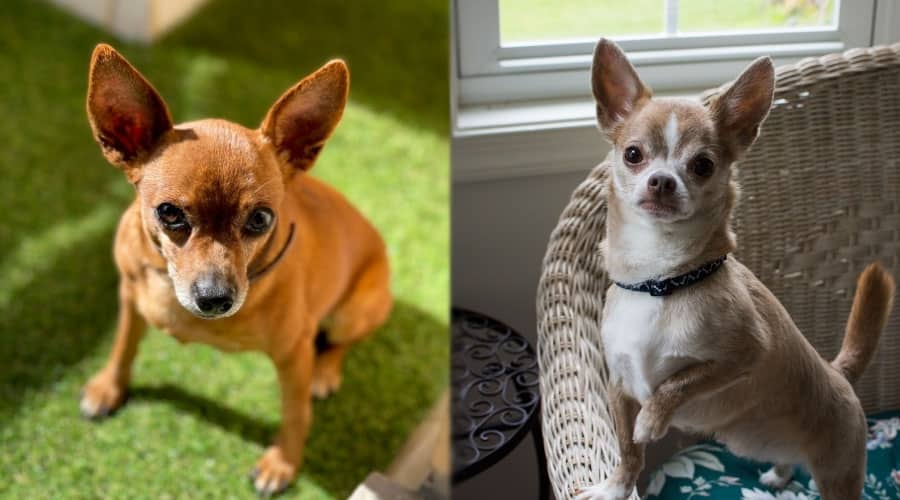
Despite there being no scientific proof the head shape of the Chihuahua affects their temperament in any way, many Chihuahua parents say deer heads are more sociable and more obedient compared to the apple head. However, it is likely their environment and upbringing form their temperament, and the shape of their heads has no bearing.
Both the apple head and the deer head are equally as confident, intelligent, and stubborn. They both employ a no-nonsense approach and do not often take no for an answer.
Despite this, they are very cheery pups who have a love for life. Chihuahuas love to play and are very friendly and affectionate toward their family. They are both described as having cheeky terrier-like temperament qualities. Chis crave companionship, which makes them very sociable, but also means they may suffer from separation anxiety.
Chihuahuas are known to bark a lot when not properly trained or socialized. This can result in the over-protectiveness of their family. They may snap if their behavior is not corrected.
Both kinds are wary of strangers, and if they don’t like something or someone, you will know about it. So, if it’s a small protective dog that you are after, these guys are known to be quite good guard dogs.
Despite being part of the canine “toy group,” they both have a medium prey drive, which means when they see something small and furry, they chase it! They are both very quick pooches. Because the deer head has longer legs and is more athletic, he will disappear out of sight much quicker than the apple head if something catches his eye.
Because of their feisty personality, Chihuahuas are popular dogs to mix with other breeds. Some great examples of this are the Chug Dog mix, the Pomchi, and the Dachshund Chihuahua mix.
Health
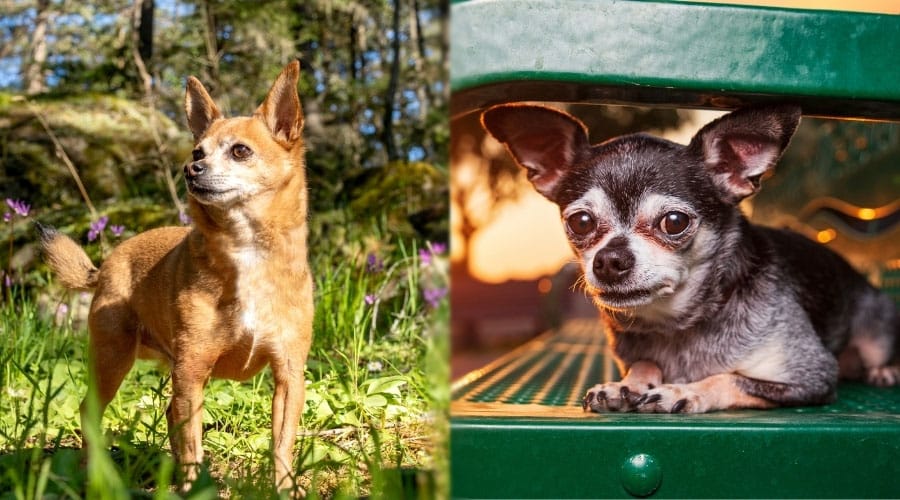
The Chihuahua’s average lifespan is 14 to 16 years. They are known to have one of the longest canine lifespans and often live to around 20 years old. The deer head, with fewer health problems than the apple head, tends to be the longest living out of the two.
Apple Head Chihuahua Health Concerns
The shape of the apple head, the shorter muzzle, and the flatter face mean he suffers more intensely from breathing problems than the deer head. One common issue is Brachycephalic Syndrome, which is an umbrella term for severe respiratory diseases caused by a flat face. It also means they suffer from the heat and have trouble regulating their body temperature if they are hot. Because these are life-threatening concerns, be sure to research what it means for you and your pup and how best to manage it.
The apple head is also more prone to suffering from a collapsing trachea. The cause is unknown, but it is believed it is because he has a smaller and weaker windpipe. Smaller dogs breathe more rapidly than larger dogs, and so if you imagine a soda straw being sucked and the walls squeezing together, blocking the airflow, that is what can happen inside the Chihuahua’s neck.
The apple head, because of his protruding eyes, is also more prone to eye injuries and infections, more so than the deer head. So, if you notice his eyes aren’t as they should be, then take him to the veterinarian immediately.
Due to the possible medical conditions either variety of Chihuahua can face, you may want to consider pet insurance when your dog is young. It can help cover the cost of care, especially in an emergency, so you can focus on your pup’s recovery.
Both Have A Soft Spot
Both the apple head and the deer head can have what is known as a molera. Simply put, this is a soft spot on his skull where his skull has not fused properly, similar to that of a newborn human baby. However, the molera on the Chihuahua’s head does not normally fuse when they mature.
Although this defect is accepted according to breed standards, this ultimately is an area of no protection, and it could be dangerous to his health. Veterinarians and many breed fanciers argue this should be bred out of the breed completely. The apple head is more likely to have a molera than the deer head.
Aside from the above, they are known to share the same health issues. According to the Chihuahua Club Of America(CCA), the Chihuahua’s parents are required to undergo a cardiac examination to test for Mitral Valve Disease, an ophthalmologist evaluation to test the health of his eyes, and a patella evaluation of his knee joints. This is all required for the pup to obtain their health certificates.
Exercise
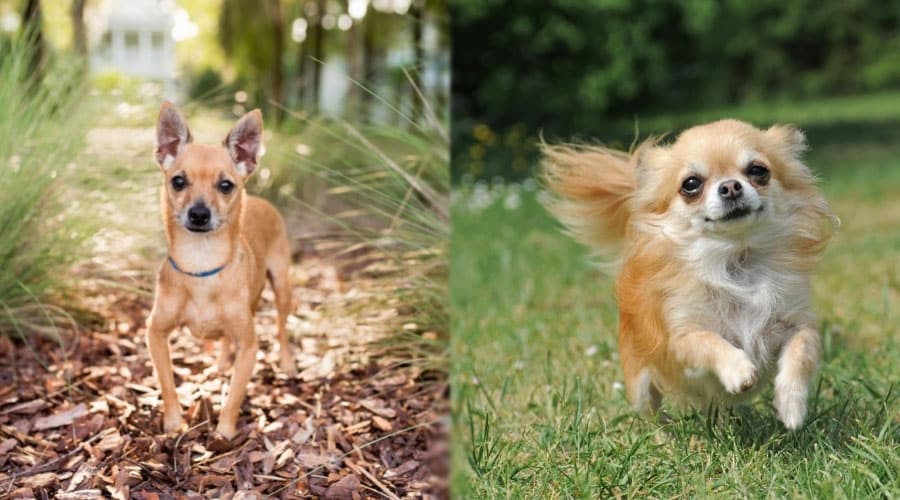
Both the apple and the deer head variety are considered to be medium-energy dogs who need about 30 minutes of exercise daily. The Chihuahua does not require particularly intense exercise. Walking and a quick game of fetch or chase will suffice. If you plan to harness train your Chihuahua, make sure you look at Chihuahua-sized harnesses to make that transition easier for this headstrong breed.
If you have an enclosed yard, they will happily have a good time chasing birds and squirrels. Be mindful that the apple head is likely to suffer more with his breathing, so on hotter days, his exercise should be monitored. If necessary, only take them out early in the morning and later at night when it is cooler.
Training
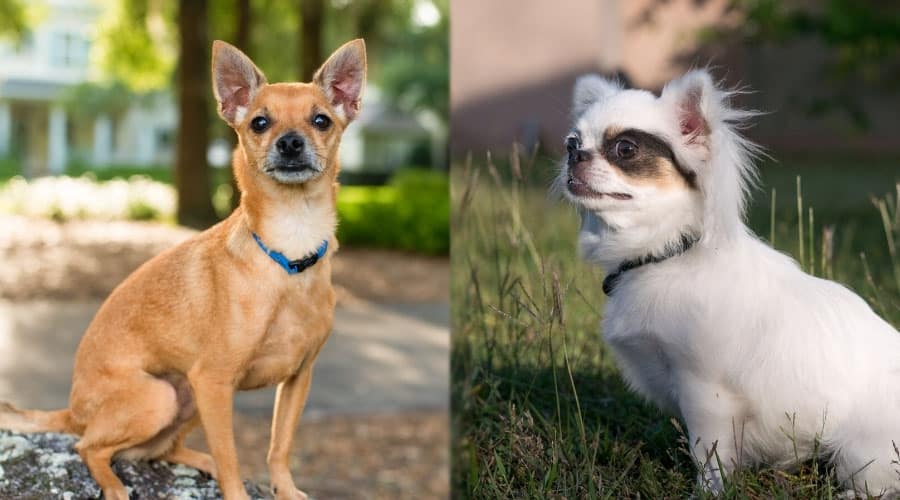
These guys are quite intelligent pups, and they are known to quickly pick up commands. However, they are fiercely independent. If they decide that today is not the day to partake in training, then you are unlikely to be successful.
Because of this stubbornness, early obedience training is key. It is also important to socialize them very early so that they are comfortable with other humans and larger dogs. This will help with their yappy barks and aloofness with strangers.
Because they are so small, Chihuahuas often get away with a lot of bad behavior. One are in particular to watch out for is potty training. They are notorious for leaving unexpected surprises around the house. You must also be sure to train out any nippy or biting behavior early on. Often, Chis get away with this type of stuff simply due to being smaller and not doing much damage to the recipient. It is sometimes referred to as “Small Dog Syndrome.” Chihuahuas can also develop separation anxiety if they are super attached. You may want to consider crate training them when you need to leave them home alone.
Nutrition
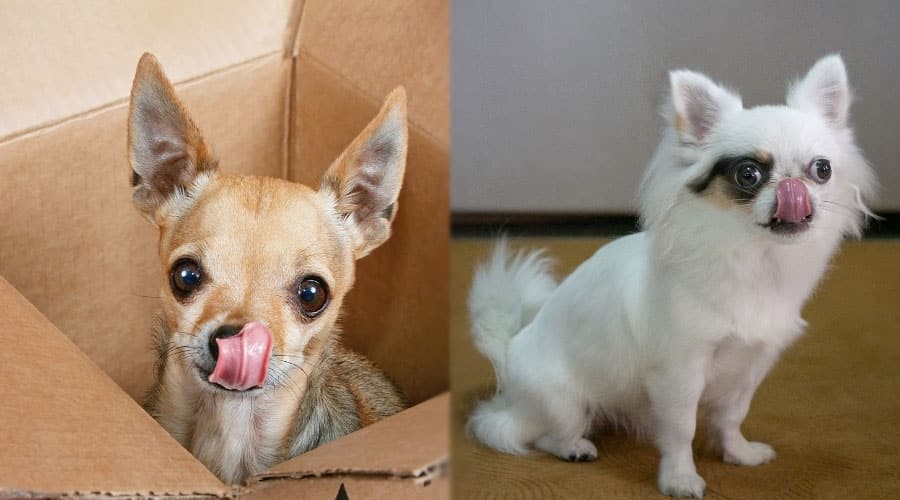
The apple head and the deer head variety have the same nutritional needs. They both require around ½ cup of food a day. However, this will be dependent on their size and activity levels. If they are a lapdog, then they will need slightly less. If they are out chasing squirrels all day, then slightly more food will be needed.
Despite being one of the smallest breeds, he still needs the best nutrients to keep him healthy, so be sure to feed him superior quality kibble. Ensure treats aren’t bigger than him, as most Chihuahuas struggle to eat standard-sized treats.
You must also be careful not to let your Chihuahua overeat. Because they are so small, even just half a pound of extra body weight can put undue pressure on the bones and joints. Be careful sharing those treats and nibbles with your Chi, even when they give you an attitude or unbearably cute looks.
Grooming
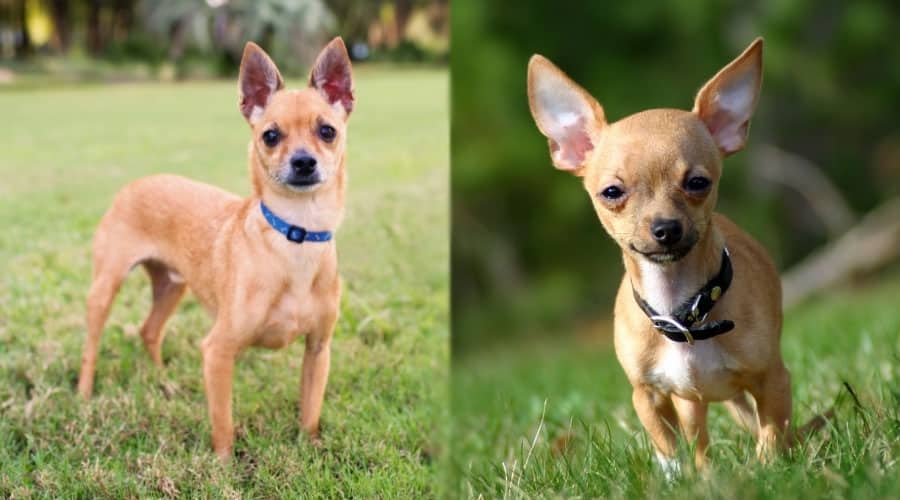
The grooming needs are the same for both the apple head and the deer head, as this is only dependent on the type of coat he has. If he is a short-haired Chihuahua, then a brush with a rubber mitt once a week will keep him looking shiny and healthy. If he is a long-haired Chihuahua, he will require brushing twice a week to ensure his hair does not get tangled.
As long as he is brushed regularly, the Chihuahua should only require one bath every two months. Chihuahuas do shed, so you’ll want to manage it with regular grooming habits.
As with any small dog, they have smaller mouths. Their teeth are more compact than those of a larger dog. Their teeth will require brushing two or three times a week to prevent any periodontal diseases. Smaller dogs have a higher risk of developing dental disease, so keeping their teeth clean must be a top priority.
Puppy Prices
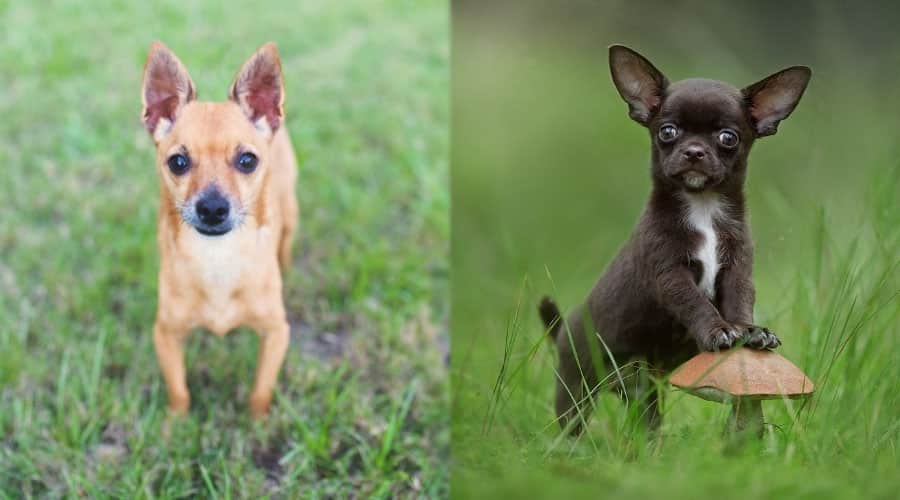
The average price of a Chihuahua puppy is about $500 from a reputable breeder for both the apple head and the deer head. If you are looking for a Chihuahua from a championship lineage with papers, then expect to pay a lot more, starting around $1,500. Prices for some higher pedigreed pups can exceed $3,500. Only apple head Chihuahuas can be shown, so this price estimate is for them, not the deer head.
The birth of apple head Chihuahuas is generally more difficult because of the shape of their skull and the difficulty that can occur passing through the birth canal. For this reason, they are often delivered by cesarean birth, so the price of the pup may be slightly more. However, as they are a common canine, breeders tend not to factor in this extra cost.
Breeders & Rescues
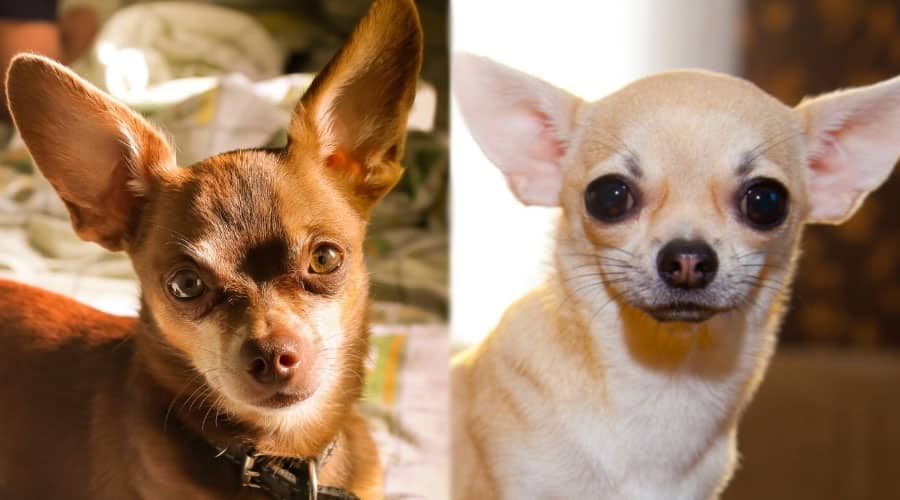
The Chihuahua Club of America (CCA) lists breeders in America by each state who have signed their code of ethics. This means they pledge to uphold stringent processes to ensure the best breeding practices. If you are interested in one particular head shape, remember to mention to the breeder that this is important to you.
Rescuing a dog is a great thing to do. Not only could you save some money compared to the costs outlined above, but you would be giving an orphaned pooch a loving home! If you are interested in rescuing a Chihuahua, then the CCA also lists rescuers state by state. You can also check with your veterinarian and local shelters to see if any dogs in your area need good homes.
Our Personal Experience With Chihuahuas
My dog Cookie was a 5-pound toy deer head Chihuahua. She was one of the sweetest, bossiest, and most animated dogs I have ever known. Though she was just 5 pounds at her heaviest, Cookie sure had a big dog attitude. Somehow, she was the leader of the pack, and my two 85-pound Labradors followed her around, ready to do her bidding. Cookie was one of a kind and brought so many happy memories to my life. I was lucky enough to be her mama for 12 years.
She required a special level of care due to her tiny size. It was particularly important to feed her the proper-sized food. Kibble for larger dogs is too hard and far too big for her mouth. While I never thought I would be a small dog person, this sweet little pup, with her huge ears, massive eyes, and big dog personality, changed my life forever. I highly recommend this little breed to anyone. They are perfect, loyal, and engaging companions who will make every day a fun one.
–Danielle DeGroot, Chihuahua owner and lifelong fan, LYD writer and researcher
Do you have experience with either the apple or deer head Chihuahua? I’d love to hear about it in the comments.
Keeping Your Chihuahua Healthy
Whether you have a deer head or an apple head Chihuahua, you are in for a lot of love. These tiny pups will keep you on your toes. Keeping your Chihuahua healthy requires a diligent commitment. They need healthy food that is suitable for their teeth size. Chihuahuas also need regular exercise. Don’t let that small stature fool you. They love to play, so keep plenty of interactive toys on hand. Along with healthy food, lots of love, and plenty of exercise, regular and preventive vet care is key to keeping your Chi healthy.
Why Trust Canine Journal?
Emma is a dog owner with over 20 years of experience. She has also worked as a professional dog walker and sitter for many years, taking care of countless dog breeds with different needs, including Chihuahuas. Emma dedicates countless hours researching the latest pet care, health, food, and training developments to keep her two best buddies and other doggy clients as happy and healthy as possible. She works alongside a professional and experienced team to bring the best, most accurate, and up-to-date information to our readers.
